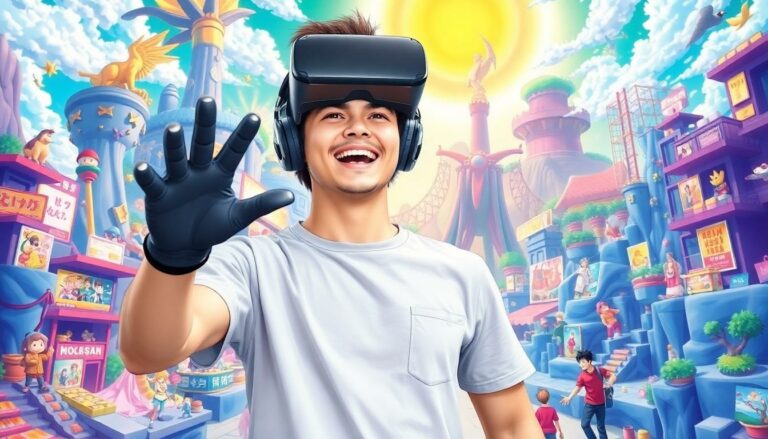Table of Contents
ToggleIn a world where attention spans are shorter than a cat video, audio-visual technology has become the superhero we didn’t know we needed. From dazzling presentations that can make even the most mundane topics seem riveting to immersive experiences that transport audiences to new worlds, these tools are revolutionizing how we communicate and connect.
Overview of Audio-Visual Technology
Audio-visual technology encompasses various tools that combine sound and visual elements to enhance communication. Components include projectors, screens, microphones, speakers and video conferencing systems. Each tool plays a vital role in creating engaging presentations.
Projectors display images and video content on large surfaces, improving visibility for audiences. Screens, whether flat or curved, enhance clarity and detail during presentations. Microphones amplify voices, ensuring speakers reach every audience member, even in large venues.
Speakers deliver sound quality essential for conveying messages effectively. Video conferencing systems facilitate remote collaboration, allowing teams to connect seamlessly from different locations. These systems offer features such as screen sharing and chat functions to enhance interaction.
Innovative technologies like virtual reality (VR) and augmented reality (AR) provide immersive experiences. VR environments transport users to different worlds, while AR overlays digital information onto real-world settings. Both technologies create engaging learning experiences and foster deeper understanding.
Educational institutions increasingly leverage audio-visual tools to enhance classroom engagement. Many schools incorporate smart boards, enabling interactive lessons that encourage student participation. Businesses, too, utilize audio-visual technology for training and marketing purposes, making information dissemination more effective.
Audio-visual technology revolutionizes how individuals and organizations communicate. Tools like projectors, microphones, and conferencing systems significantly impact engagement and information delivery. As technology continues to advance, integration of new tools ensures dynamic experiences in various settings.
Types of Audio-Visual Technology Examples

Audio-visual technology encompasses various tools that enhance communication and learning. Here are key types commonly used.
Interactive Whiteboards
Interactive whiteboards facilitate real-time collaboration. Educators and professionals utilize touchscreen technology to illustrate concepts and engage audiences. Users can draw, write, and share content seamlessly. These boards often integrate with other software tools, enhancing overall accessibility. Many systems allow for saving and sharing notes, which supports collaborative learning and business meetings.
Video Conferencing Systems
Video conferencing systems revolutionize remote communication. They enable real-time visual interactions between participants in different locations. Features like screen sharing enhance presentations, making it easier to convey information. Common platforms include Zoom, Microsoft Teams, and Google Meet, all offering user-friendly interfaces. Integration with chat functions allows discussion alongside video, fostering effective collaboration.
Sound Systems
Sound systems ensure audio clarity during presentations and events. Components like microphones, amplifiers, and speakers work together to deliver high-quality sound. Different types of microphones, such as lapel or handheld, cater to specific speaking environments. Proper sound systems enhance audience engagement by providing clear audio to large groups. They are crucial for creating immersive experiences in auditoriums, classrooms, and conferences.
Projectors and Displays
Projectors and displays play vital roles in visual presentations. They project images and videos onto screens, maximizing the audience’s view. Various technologies, including LCD, DLP, and LED, serve different settings and needs. Displays can also include digital signage for constant information flow in public spaces. High-quality projectors enhance color accuracy and brightness, ensuring clear visuals in diverse lighting conditions.
Benefits of Audio-Visual Technology
Audio-visual technology offers significant advantages across various sectors, greatly enhancing engagement and communication.
Enhanced Learning Experience
Interactive features engage students actively. Technologies like virtual reality (VR) provide immersive simulations, facilitating deeper understanding of complex subjects. Educational tools, such as interactive whiteboards, allow real-time participation, making lessons dynamic. Enhancements in visuals mean clearer presentations, aiding retention. Diverse formats, including videos and animations, cater to different learning styles. Students demonstrate improved performance when engaging with materials that incorporate audio-visual elements. Overall, these innovative tools transform traditional classrooms into interactive learning environments.
Improved Communication
Effective communication becomes straightforward with audio-visual technology. Video conferencing platforms enable seamless remote connections, allowing teams to collaborate from various locations. Clarity in presentation improves when using projectors and high-quality sound systems. Engaging visuals replace static content, increasing audience interest. Accessible features, like screen sharing, make it easy to share information instantly. Teams communicate more effectively, ensuring everyone stays on the same page. Such advancements simplify the exchange of ideas in both educational and corporate settings.
Challenges in Implementing Audio-Visual Technology
Audio-visual technology presents various challenges that organizations face during implementation. Understanding these obstacles helps in formulating effective strategies for successful integration.
Cost Considerations
Budget constraints often limit the adoption of advanced audio-visual technology. Initial investments in equipment such as projectors, microphones, and speakers can be significant. Regular maintenance and updates add to ongoing expenses. Organizations must consider costs associated with training staff on new systems as well. Selecting affordable yet reliable technology sometimes requires thorough research to find the best options that fit within financial parameters.
Technical Limitations
Inadequate technical infrastructure can hinder the effectiveness of audio-visual technology. Bandwidth issues frequently disrupt video conferencing quality, impacting communication. Compatibility among different devices often leads to integration challenges. Limited technical expertise within teams may create difficulties in troubleshooting and system operations. Organizations must assess current technology capabilities to ensure they support the implementation of desired audio-visual tools effectively.
Future Trends in Audio-Visual Technology
Artificial intelligence (AI) increasingly influences audio-visual technology, driving personalized user experiences. AI algorithms analyze content and user behavior to deliver tailored recommendations for video and audio materials. This shift enhances engagement and facilitates access to relevant information.
Virtual reality and augmented reality continue to dominate as transformative tools. Enhanced visual immersion offers users the ability to interact with information in unprecedented ways. In education, VR environments engage students, enabling them to practice real-world scenarios safely.
3D holography is gaining traction, offering exciting visual experiences. These advanced displays create lifelike images that captivate audiences, making them ideal for marketing and entertainment events. Businesses can utilize holograms to showcase products engagingly.
Cloud-based solutions are revolutionizing video conferencing capabilities. Teams can access resources remotely, facilitating collaboration regardless of location. Integration with existing software tools ensures seamless communication, enhancing productivity for businesses and educational institutions alike.
Interactive displays are becoming more sophisticated. Touch-enabled surfaces allow users to manipulate content effortlessly, fostering dynamic discussions. Such technology proves invaluable in educational and corporate settings alike.
Sustainability also emerges as a key consideration. Innovations prioritize energy-efficient systems, ensuring organizations can invest in technology while minimizing their environmental impact. Adopting eco-friendly practices strengthens corporate responsibility and appeals to environmentally-conscious consumers.
Overall, the future of audio-visual technology holds exciting potential. These trends promise to reshape how individuals connect, engage, and share information across various sectors. With advancements like AI, VR, and interactive solutions, the evolution of audio-visual systems continues to enhance communication and collaboration in meaningful ways.
Audio-visual technology is reshaping the landscape of communication and engagement across various sectors. Its ability to enhance presentations and create immersive experiences is transforming how information is conveyed and understood. As organizations adopt tools like VR and AR, they unlock new dimensions of interaction that foster deeper connections.
While challenges exist in implementation, the benefits far outweigh the hurdles. With advancements in AI and cloud-based solutions, the future of audio-visual technology looks promising. Organizations that embrace these innovations will likely see improved collaboration and heightened engagement, setting the stage for more effective communication strategies. The journey of integrating audio-visual technology is just beginning, and its impact will continue to evolve in exciting ways.




